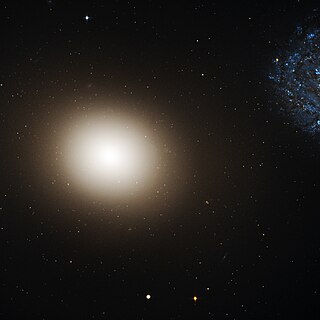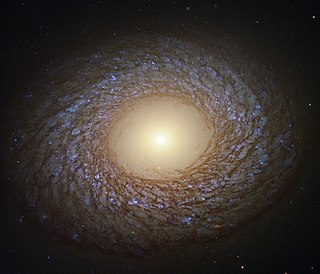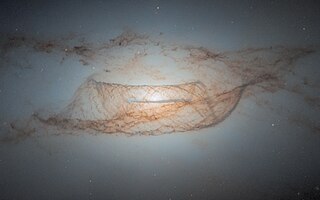
Messier 100 is a grand design intermediate spiral galaxy in the southern part of the mildly northern Coma Berenices. It is one of the brightest and largest galaxies in the Virgo Cluster and is approximately 55 million light-years from our galaxy, its diameter being 107,000 light years, and being about 60% as large. It was discovered by Pierre Méchain in 1781 and 29 days later seen again and entered by Charles Messier in his catalogue "of nebulae and star clusters". It was one of the first spiral galaxies to be discovered, and was listed as one of fourteen spiral nebulae by Lord William Parsons of Rosse in 1850. NGC 4323 and NGC 4328 are satellite galaxies of M100; the former is connected with it by a bridge of luminous matter.

Messier 61 is an intermediate barred spiral galaxy in the Virgo Cluster of galaxies. It was first discovered by Barnaba Oriani on May 5, 1779, six days before Charles Messier discovered the same galaxy. Messier had observed it on the same night as Oriani but had mistaken it for a comet. Its distance has been estimated to be 45.61 million light years from the Milky Way Galaxy. It is a member of the M61 Group of galaxies, which is a member of the Virgo II Groups, a series of galaxies and galaxy clusters strung out from the southern edge of the Virgo Supercluster.

Messier 58 is an intermediate barred spiral galaxy with a weak inner ring structure located within the constellation Virgo, approximately 68 million light-years away from Earth. It was discovered by Charles Messier on April 15, 1779 and is one of four barred spiral galaxies that appear in Messier's catalogue. M58 is one of the brightest galaxies in the Virgo Cluster. From 1779 it was arguably the farthest known astronomical object until the release of the New General Catalogue in the 1880s and even more so the publishing of redshift values in the 1920s.

Messier 60 or M60, also known as NGC 4649, is an elliptical galaxy approximately 57 million light-years away in the equatorial constellation of Virgo. Together with NGC 4647, it forms a pair known as Arp 116. Messier 60 and nearby elliptical galaxy Messier 59 were discovered by Johann Gottfried Koehler in April 1779, observing a comet in the same part of the sky. Charles Messier added both to his catalogue about three days after this.

Messier 99 or M99, also known as NGC 4254 or St. Catherine's Wheel, is a grand design spiral galaxy in the northern constellation Coma Berenices approximately 15,000,000 parsecs from the Milky Way. It was discovered by Pierre Méchain on 17 March 1781. The discovery was then reported to Charles Messier, who included the object in the Messier Catalogue of comet-like objects. It was one of the first galaxies in which a spiral pattern was seen. This pattern was first identified by Lord Rosse in the spring of 1846.

NGC 6946, sometimes referred to as the Fireworks Galaxy, is a face-on intermediate spiral galaxy with a small bright nucleus, whose location in the sky straddles the boundary between the northern constellations of Cepheus and Cygnus. Its distance from Earth is about 25.2 million light-years or 7.72 megaparsecs, similar to the distance of M101 in the constellation Ursa Major. Both were once considered to be part of the Local Group, but are now known to be among the dozen bright spiral galaxies near the Milky Way but beyond the confines of the Local Group. NGC 6946 lies within the Virgo Supercluster.

NGC 4725 is an intermediate barred spiral galaxy with a prominent ring structure, located in the northern constellation of Coma Berenices near the north galactic pole. It was discovered by German-born British astronomer William Herschel on April 6, 1785. The galaxy lies at a distance of approximately 40 megalight-years from the Milky Way. NGC 4725 is the brightest member of the Coma I Group of the Coma-Sculptor Cloud, although it is relatively isolated from the other members of this group. This galaxy is strongly disturbed and is interacting with neighboring spiral galaxy NGC 4747, with its spiral arms showing indications of warping. The pair have an angular separation of 24′, which corresponds to a projected linear separation of 370 kly. A tidal plume extends from NGC 4747 toward NGC 4725.

NGC 1316 is a lenticular galaxy about 60 million light-years away in the constellation Fornax. It is a radio galaxy and at 1400 MHz is the fourth-brightest radio source in the sky.

NGC 4639 is a barred spiral galaxy located in the equatorial constellation of Virgo. It was discovered by German-born astronomer William Herschel on 12 April 1784. John L. E. Dreyer described it as "pretty bright, small, extended, mottled but not resolved, 12th magnitude star 1 arcmin to southeast". This is a relatively nearby galaxy, lying approximately 72 million light-years away from the Milky Way. It is a companion to NGC 4654, and the two appear to have interacted roughly 500 million years ago. NGC 4639 is a member of the Virgo Cluster.

NGC 3432 is an edge-on spiral galaxy that can be found in the northern constellation of Leo Minor. It was discovered by German-British astronomer William Herschel on March 19, 1787. This galaxy is located at a distance of 40 million light-years (12.3 Mpc) from the Milky Way. It is interacting with UGC 5983, a nearby dwarf galaxy, and features tidal filaments and intense star formation. Because of these features, it was listed in Halton Arp's Atlas of Peculiar Galaxies.

NGC 2775, also known as Caldwell 48, is a spiral galaxy in the constellation Cancer. It is 67 million light-years away from the Milky Way. It was discovered by William Herschel in 1783. NGC 2775 belongs to the Antlia-Hydra Cluster of galaxies and is the most prominent member of the NGC 2775 Group, a small galaxy group in the Virgo Super-cluster, along with the Local Group. Other members of the NGC 2775 Group include NGC 2777 and UGC 4781.

NGC 4666 is a spiral galaxy in the equatorial constellation of Virgo, located at a distance of approximately 55 megalight-years from the Milky Way. It was discovered by the German-born astronomer William Herschel on February 22, 1784. It is a member of the Virgo II Groups, a series of galaxies and galaxy clusters strung out from the southern edge of the Virgo Supercluster. John L. E. Dreyer described it as "bright, very large, much extended 45°±, pretty suddenly brighter middle". It is a member of an interacting system with NGC 4668 and a dwarf galaxy, and belongs to a small group that also includes NGC 4632.

Arp 271 is a pair of similarly sized interacting spiral galaxies, NGC 5426 and NGC 5427, in the constellation of Virgo. It is not certain whether the galaxies are going to eventually collide or not. They will continue interacting for tens of millions of years, creating new stars as a result of the mutual gravitational attraction between the galaxies, a pull seen in the bridge of stars already connecting the two. Located about 130 million light-years away, the Arp 271 pair is about 130,000 light-years across. It was originally discovered in 1785 by William Herschel. It is speculated, that the Milky Way will undergo a similar collision in about five billion years with the neighbouring Andromeda Galaxy, which is currently located about 2.6 million light-years away.

NGC 5584 is a barred spiral galaxy in the constellation Virgo. It was discovered July 27, 1881 by American astronomer E. E. Barnard. Distance determination using Cepheid variable measurements gives an estimate of 75 million light years, whereas the tip of the red-giant branch approach yields a distance of 73.4 million light years. It is receding with a heliocentric radial velocity of 1,637 km/s. It is a member of the Virgo III Groups, a series of galaxies and galaxy clusters strung out to the east of the Virgo Supercluster of galaxies.

NGC 4030 is a grand design spiral galaxy located about 64 million light years away in the constellation Virgo. It is a member of the NGC 4030 Group of galaxies, which is a member of the Virgo II Groups, a series of galaxies and galaxy clusters strung out from the southern edge of the Virgo Supercluster. With an apparent visual magnitude of 10.6, it is visible with a small telescope as a 3 arc minute wide feature about 4.75° to the southeast of the star Beta Virginis. It is inclined by an angle of 47.1° to the line of sight from the Earth and is receding at a velocity of 1,465 km/s.

NGC 2613 is a spiral galaxy in the southern constellation of Pyxis, next to the western constellation border with Puppis. It was discovered by the German-born astronomer William Herschel on November 20, 1784. With an apparent visual magnitude of 10.5, the galaxy is faintly visible using a telescope with a 100 mm (4 in) aperture. It appears spindle-shaped as it is almost edge-on to observers on Earth.

NGC 4424 is a spiral galaxy located in the equatorial constellation of Virgo. It was discovered February 27, 1865 by German astronomer Heinrich Louis d'Arrest. This galaxy is located at a distance of 13.5 million light years and is receding with a heliocentric radial velocity of 442 km/s. It has a morphological class of SB(s)a, which normally indicates a spiral galaxy with a barred structure (SB), no inner ring feature (s), and tightly-wound spiral arms (a). The galactic plane is inclined at an angle of 62° to the line of sight from the Earth. It is a likely member of the Virgo Cluster of galaxies.

NGC 4647 is an intermediate spiral galaxy estimated to be around 63 million light-years away in the constellation of Virgo. It was discovered by astronomer William Herschel on March 15, 1784. NGC 4647 is listed along with Messier 60 as being part of a pair of galaxies called Arp 116; their designation in Halton Arp's Atlas of Peculiar Galaxies. The galaxy is located on the outskirts of the Virgo Cluster.

NGC 4753 is a lenticular galaxy located about 60 million light-years away in the constellation of Virgo. NGC 4753 was discovered by astronomer William Herschel on February 22, 1784. It is notable for having distinct dust lanes that surround its nucleus. It is a member of the NGC 4753 Group of galaxies, which is a member of the Virgo II Groups, a series of galaxies and galaxy clusters strung out from the southern edge of the Virgo Supercluster.

NGC 5774 is an intermediate spiral galaxy approximately 71 million light-years away from Earth in the constellation of Virgo. It was discovered by Irish engineer Bindon Stoney on April 26, 1851.























